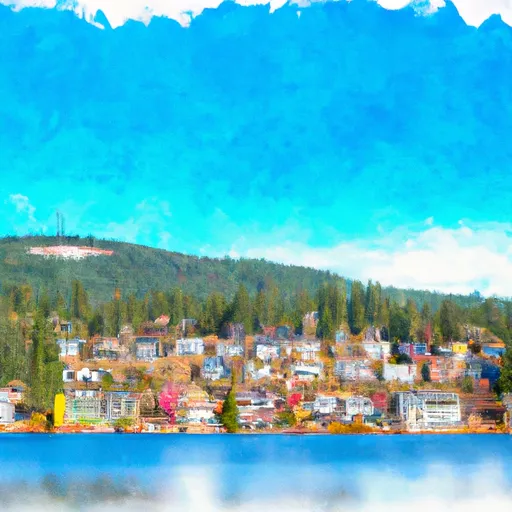-
 Snoflo Premium
Snoflo Premium
Get unlimited access to all our content
With no Ad interruptions! - Start Your Free Trial Login with existing account
Loon-Lake
Eden Index
Climate
8.4
•
Recreation
2.9
•
Community
1.8
•
Safeguard
4.8/10

Loon Lake is a charming community located in northeastern Washington state. Known for its natural beauty and recreational opportunities, Loon Lake offers a delightful environment for outdoor enthusiasts. The climate in Loon Lake is characterized by four distinct seasons. Summers are warm and dry, with temperatures reaching the mid-80s°F (around 30°C), creating perfect conditions for water-related activities. Winters are cold and snowy, providing opportunities for snowshoeing, cross-country skiing, and ice fishing.
Loon Lake itself is a freshwater reservoir, fed by both surface and groundwater sources. The hydrology constituents of the lake include inflows from nearby streams and precipitation runoff. The lake is rich in aquatic life, making it a popular spot for fishing enthusiasts. Anglers can find various fish species, including trout, bass, and catfish.
Outdoor recreation opportunities in Loon Lake are abundant. The lake offers excellent fishing and boating experiences, making it ideal for water sports enthusiasts. The surrounding area boasts numerous hiking trails, providing opportunities for exploration and wildlife observation. The nearby Colville National Forest offers camping and hunting opportunities, attracting outdoor enthusiasts year-round. With its diverse recreational offerings and stunning natural environment, Loon Lake is a destination worth exploring for nature lovers and adventure seekers.
What is the Eden Index?
The Snoflo Eden Index serves as a comprehensive rating system for regions, evaluating their desirability through a holistic assessment of climate health, outdoor recreation opportunities, and natural disaster risk, acknowledging the profound impact of these factors on livability and well-being.
Climate Health Indicator (CHI): 8.4
Loon-Lake receives approximately
620mm of rain per year,
with humidity levels near 74%
and air temperatures averaging around
8°C.
Loon-Lake has a plant hardyness factor of
6, meaning
plants and agriculture in this region thrive during a short period during spring and early summer. Most
plants will die off during the colder winter months.
By considering the ideal temperature range, reliable water supplies, clean air, and stable seasonal rain or snowpacks, the Climate Health Indicator (CHI) underscores the significance of a healthy climate as the foundation for quality living.
A healthy climate is paramount for ensuring a high quality of life and livability in a region, fostering both physical well-being and environmental harmony. This can be characterized by ideal temperatures, reliable access to water supplies, clean air, and consistent seasonal rain or snowpacks.
Weather Forecast
Streamflow Conditions
Upper Columbia
Area Rivers
Upper Columbia
Snowpack Depths
Upper Columbia
Reservoir Storage Capacity
Upper Columbia
Groundwater Levels
Recreational Opportunity Index (ROI): 2.9
The Recreational Opportunity Index (ROI) recognizes the value of outdoor recreational options, such as parks, hiking trails, camping sites, and fishing spots, while acknowledging that climate plays a pivotal role in ensuring the comfort and consistency of these experiences.
Access to outdoor recreational opportunities, encompassing activities such as parks, hiking, camping, and fishing, is crucial for overall well-being, and the climate plays a pivotal role in enabling and enhancing these experiences, ensuring that individuals can engage in nature-based activities comfortably and consistently.
Camping Areas
| Campground | Campsites | Reservations | Toilets | Showers | Elevation |
|---|---|---|---|---|---|
| Flodelle Creek- State Forest | 8 | 3,105 ft | |||
| Chewelah City Park | 14 | 1,669 ft | |||
| Spokane Lake Campground- State Forest | 9 | 1,706 ft | |||
| Riverside State Park | 32 | 1,693 ft | |||
| Starvation Lake- State Forest | 6 | 2,425 ft |
Nearby Fishing
Nearby Ski Areas
Catastrophe Safeguard Index (CSI):
The Catastrophe Safeguard Index (CSI) recognizes that natural disaster risk, encompassing floods, fires, hurricanes, and tornadoes, can drastically affect safety and the overall appeal of an area.
The level of natural disaster risk in a region significantly affects safety and the overall livability, with climate change amplifying these risks by potentially increasing the frequency and intensity of events like floods, fires, hurricanes, and tornadoes, thereby posing substantial challenges to community resilience and well-being.
Community Resilience Indicator (CRI): 1.8
The Community Resilience Indicator (CRI) recognizes that education, healthcare, and socioeconomics are crucial to the well-being of a region. The CRI acknowledges the profound impact of these elements on residents' overall quality of life. By evaluating educational resources, healthcare accessibility, and economic inclusivity, the index captures the essential aspects that contribute to a thriving community, fostering resident satisfaction, equity, and social cohesion.

